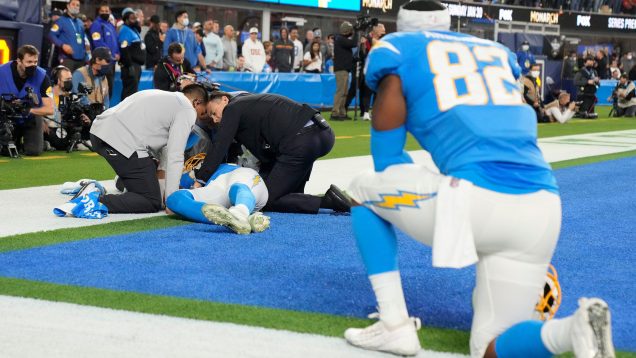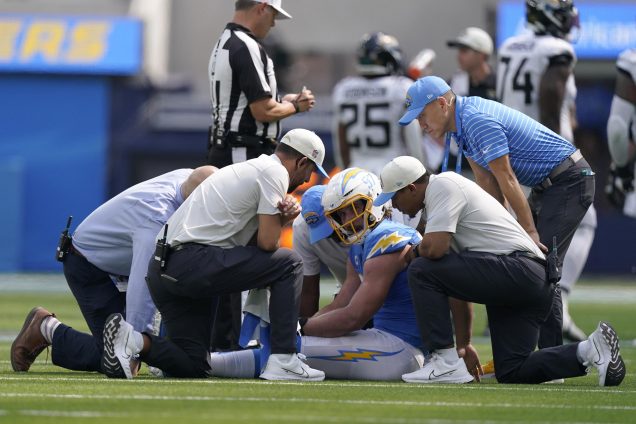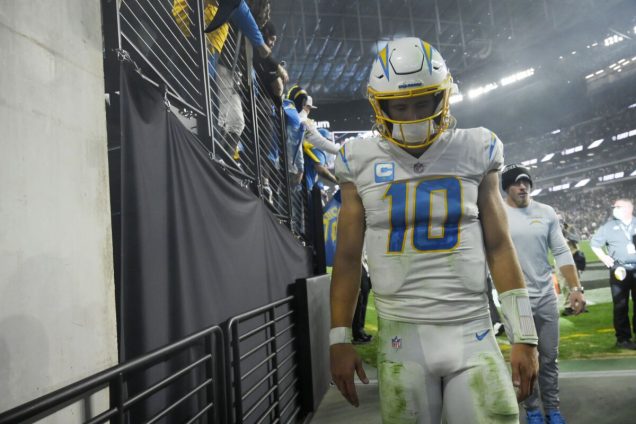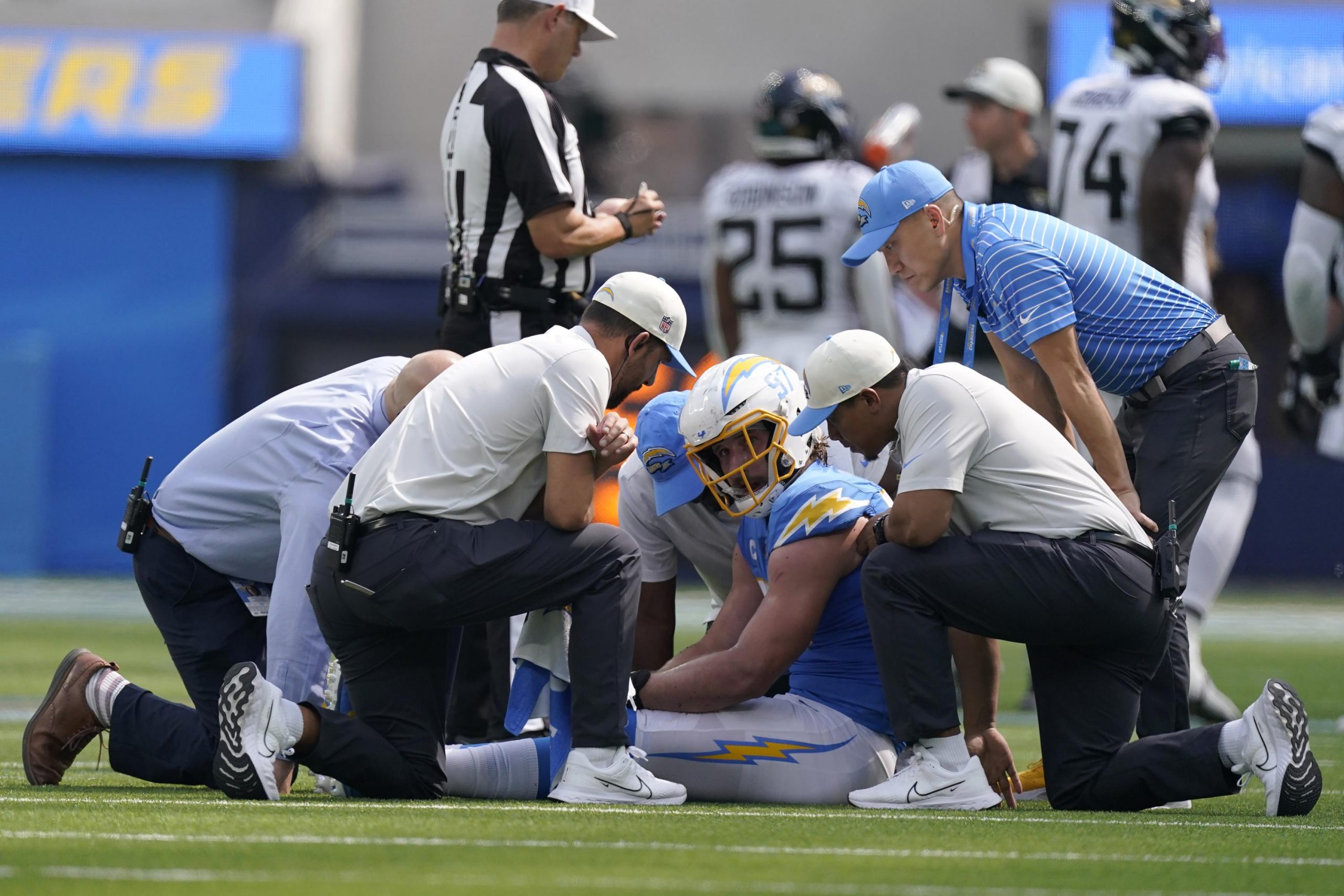The B-Gap: The Chargers are decimated by injuries, again. Where do they go from here?
By Sam Robb O’Hagan
Football is weird.
For a game that can be micromanaged like no other, it is remarkable just how often it is decided by inexplicable trends.
The layers upon layers of schematic reason that can control the game down as far as the individual movements of individual players make the sport one of the most complex and analytical in the entire world. Despite its barbaric physicality, it has become very much a chess match on grass.
Still, the results on the field never seem to make sense. Perhaps no franchise embodies the illogical nature of a supposedly logical sport quite like the Los Angeles Chargers , whose impressively consistent merit on paper has almost always found a way to undo itself on the field.
The reason behind that constant disappointment is obvious, especially in the six seasons since the franchise’s relocation back to Los Angeles: The team is incapable of staying healthy.
Football fans are probably too quick to call a team “cursed” as a means to justify a usual pattern of results . No, the Bears are not cursed into infinitely bad quarterback play, nor are the Lions from, say, winning a playoff game ; both of those organizations clearly just haven’t figured out how to be successful.
For the Chargers, the term seems a lot less radical. To a certain extent, injuries are completely out of anyone’s control, all boiling down to fate. In that sense, given the consistency of the role that critical injuries have played in unfastening all of LA’s otherwise adequate work, the Chargers may actually be cursed.
Medical mishaps like a team doctor puncturing the lung of quarterback Tyrod Taylor during a pregame injection in 2020 would suggest the team can do a much better job of improving their own luck. Nevertheless, by even the cruelest of standards, the Chargers have been extraordinarily unlucky.

Take this year’s team, who entered the season with reasonable expectations for a Super Bowl run, as usual. Seven weeks in, they sit at an uninspiring 4–3, barely scraping by subpar teams and falling short against contenders. They’re moving through the season the typical Charger Way, no matter how strong a conviction there is in their attempts to separate themselves from that script.
There is, of course, a familiar caveat to the extreme disappointment of the young 2022 season: The team continues to be decimated by injuries.
Two of the team’s highest-paid defensive players (by 2022 cap hit, according to Spotrac) are on Injured Reserve, including edge rusher Joey Bosa, whose $28.25 million cap hit is responsible for an incredible 13% of the team’s salary cap. The other, cornerback JC Jackson, was the team’s marquee free agent acquisition at the defense’s most pressing need. Jackson alone is responsible for almost 4% of LA’s available salary cap.
There are 53 players on an active NFL roster, and even more under contract; four percent of the team’s entire payroll being allocated to one player makes that player’s value extensive, 13 percent makes him almost invaluable. The Chargers have now lost one for the remainder of the season, the other for at least five more weeks after missing the previous three.
Wide receiver Keenan Allen, owning the next-highest cap allocation behind Bosa, has played just 45 snaps this season, according to FantasyPros. Allen is battling a nagging hamstring injury suffered in Week 1.
In Week 7, his first game back from a five-game absence, Allen recorded two catches for just 11 yards, and didn’t enter the game after halftime. Mike Williams, the next man up in the receiving pecking order, is expected to miss the next four weeks with an ankle injury. The man next behind him, Joshua Palmer, missed Week 7 with a concussion, and his status remains unclear. Left tackle Rashawn Slater, the team’s first-round pick from the 2021 draft and one of the best offensive lineman in all of football last season, is expected to miss the rest of this season after playing in just three games due to a torn bicep.

The injuries are everywhere, again. Of course, there is little the Chargers can do to prevent them. Players are going to get hurt. Statistically, it is almost a certainty, yet the Chargers never seem even the least bit prepared for them.
That has been the underlying theme of their time back in Los Angeles, beyond the obvious misfortune on the injury report: Once a starter does go down, the reinforcements behind them have rarely been sufficient. They are team that has always lacked depth, despite having first-hand experience in understanding the value of a deep roster like few other teams across the league.
In 2022, that problem is reflected most directly along the offensive line, who lost Slater to a presumed season-ending torn bicep in Week 3. Of the remaining options at offensive tackle to fill in for Slater — Trey Pipkins III, Jamaree Salyer and Storm Norton — none belong on the starting offensive line for a championship contender.
Pipkins had a 54.8 player grade in the only other season he played more than 250 snaps, per Pro Football Focus. Norton was an undrafted free agent and earned a 60.3 grade in over 1,000 snaps last season. Salyer was the 195th overall selection in the 2022 Draft and is in his rookie season. None should be anywhere near the field, yet all three have been thrusted into critical roles this season as a result of a single starting domino falling. The product has been an offensive line that is 22nd in pass-block win rate and dead last in run-block win rate, according to ESPN.
It’s a similar story on the other side of the line of scrimmage. LA’s vaunted defensive line, injected with superstardom through the offseason acquisition of Khalil Mack, has fallen apart after Bosa’s injury.
They’re a disheartening 28th in pass-rush win rate, and are again miserable against the run , allowing over 137 yards on the ground per game, the seventh-most in the league.
Like Slater, none of the players in position to assume Bosa’s role look the part. Both an aging Kyle Van Noy — who has never played well anywhere outside of New England — and fourth-round pick Chris Rumph have failed to record a sack.
It’s also worth noting that Bosa is no stranger to significant injuries , having missed 21 games throughout his career , so the team should’ve been prepared for this possibility.
And Bosa isn’t the only one; Allen has missed 19 career games, and Williams has missed eight. The Chargers’ offense strongly relies on both, and they’re injured again as the unit continues to underperform.

The problem in LA is not that the team isn’t getting unlucky. They are. It’s that the Chargers continue to let that misfortune destroy their seasons ; first by continuing to build their team around evidently injury-prone players, then by somehow failing to consider the value in their replacements.
How is it that this happens every season? It has to be bigger than just an unfortunate dealing of the cards.
As they limp into the halfway-point of another disappointing season, this current iteration of the Chargers find themselves at a crossroads. Their foundational core of the last few seasons led by Allen, Williams and Bosa — built to support star quarterback Justin Herbert — are once again failing to match justifiably high expectations.
They are a group teaming with talent on paper that can be matched by few others around the league. Their persisting downfall is an unforgiving reality of the sport that doesn’t show up on paper ; ability and availability are not mutually exclusive.
The Chargers have a choice : Continue to bullishly commit to an injury-prone core through pricey acquisitions, or move on from their increasingly unreliable staples of the last half-decade.
Given how familiar the disheartening feeling of a failed season has become in Los Angeles, the answer has never looked clearer.
